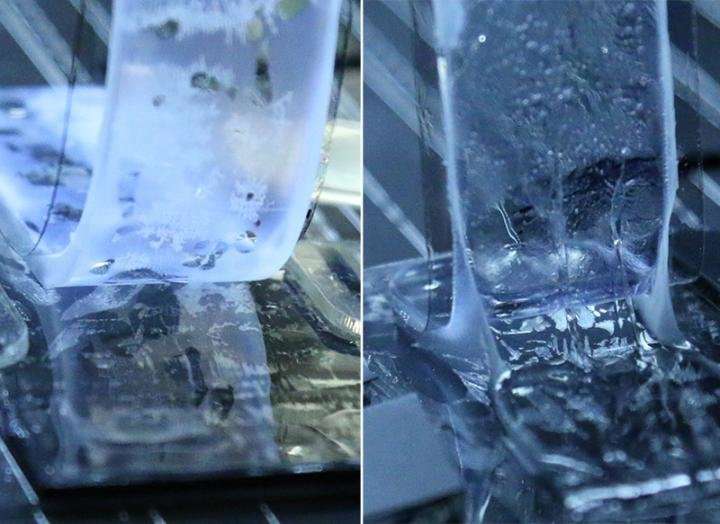A new way to combine soft materials

Every complex human tool, from the first spear to latest smartphone, has contained multiple materials wedged, tied, screwed, glued or soldered together. But the next generation of tools, from autonomous squishy robots to flexible wearables, will be soft. Combining multiple soft materials into a complex machine requires an entirely new toolbox—after all, there's no such thing as a soft screw.
Current methods to combine soft materials are limited, relying on glues or surface treatments that can restrict the manufacturing process. For example, it doesn't make much sense to apply glue or perform surface treatment before each drop of ink falls off during a 3D printing session. But now, researchers from the Harvard John A. Paulson School of Engineering and Applied Sciences (SEAS) have developed a new method to chemically bond multiple soft materials independent of the manufacturing process. In principle, the method can be applied in any manufacturing processes, including but 3D printing and coating. This technique opens door to manufacturing more complex soft machines.
The research is published in Nature Communications.
"This technique allows us to bond various hydrogels and elastomers in various manufacturing processes without sacrificing the properties of the materials," said Qihan Liu, a postdoctoral fellow at SEAS and co-first author of the paper. "We hope that this will pave the way for rapid-prototyping and mass-producing biomimetic soft devices for healthcare, fashion and augmented reality."
The researchers focused on the two most-used building blocks for soft devices, hydrogels (conductors) and elastomers (insulators). To combine the materials, the team mixed chemical coupling agents into the precursors of both hydrogels and elastomers. The coupling agents look like molecular hands with small tails. As the precursors form into material networks, the tail of the coupling agents attaches to the polymer networks, while the hand remains open. When the hydrogel and elastomer are combined in the manufacturing process, the free hands reach across the material boundary and shake, creating chemical bonds between the two materials. The timing of the "handshake" can be tuned by multiple factors such as temperature and catalysts, allowing different amounts of manufacturing time before bonding happens.
The researchers showed that the method can bond two pieces of casted materials like glue but without applying a glue layer on the interface. The method also allows coating and printing of different soft materials in different sequences. In all cases, the hydrogel and elastomer created a strong, long-lasting chemical bond.
"The manufacturing of soft devices involves several ways of integrating hydrogels and elastomers, including direct attachment, casting, coating, and printing," said Canhui Yang, a postdoctoral fellow at SEAS and co-first author of the paper. "Whereas every current method only enables two or three manufacturing methods, our new technique is versatile and enables all the various ways to integrate materials."
The researchers also demonstrated that hydrogels—which as the name implies are mostly water—can be made heat resistant in high temperatures using a bonded coating, extending the temperature range that hydrogel-based device can be used. For example, a hydrogel-based wearable device can now be ironed without boiling.
"Several recent findings have shown that hydrogels can enable electrical devices well beyond previously imagined," said Zhigang Suo, Allen E. and Marilyn M. Puckett Professor of Mechanics and Materials at SEAS and senior author of the paper. "These devices mimic the functions of muscle, skin, and axon. Like integrated circuits in microelectronics, these devices function by integrating dissimilar materials. This work enables strong adhesion between soft materials in various manufacturing processes. It is conceivable that integrated soft materials will enable spandex-like touchpads and displays that one can wear, wash, and iron."
More information: Qihan Liu et al. Bonding dissimilar polymer networks in various manufacturing processes, Nature Communications (2018). DOI: 10.1038/s41467-018-03269-x
Journal information: Nature Communications





















